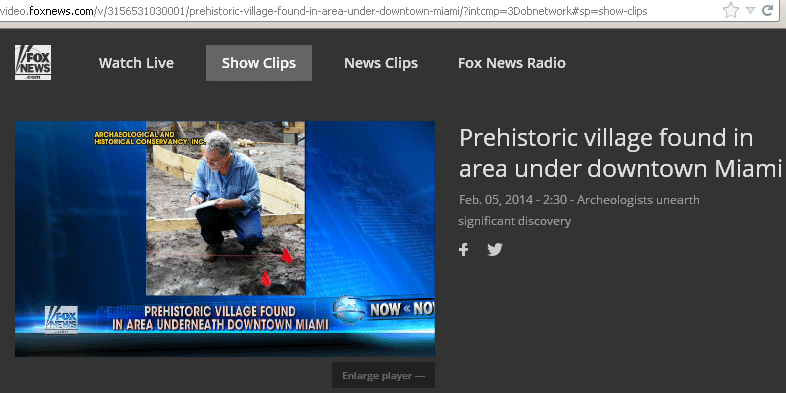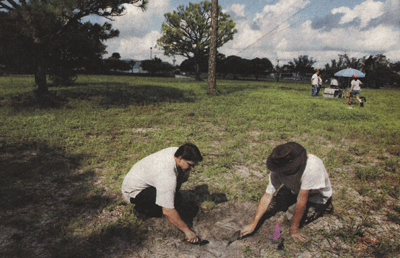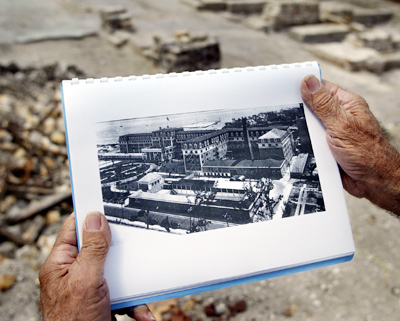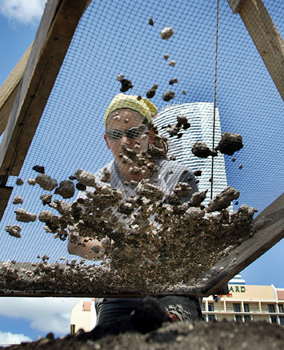
More Articles
| Fox News: January 16, 2006, Indian Burial Grounds Discoverd in Miami |
| Sun-Sentinel: October 5, 2004, GPR at Deerfield Beach Cemetery |
| Sun-Sentinel: April 21, 2004, Remains of Henry Flagler Hotel in Miami |

See how Mnemotrix Systems, Inc. assisted AHC with GPR
Posted and published in the Sun-Sentinel, South Florida, October 5th, 2004
High-tech team hopes to learn whether Deerfield lot is an old graveyard
By Susannah Bryan
DEERFIELD BEACH · It may appear ordinary soil, but some say a mystery lies beneath.
To hear old-timers tell it, this patch of land is hallowed ground that may still hold the bones of people who died long ago.
The wooden crosses that marked their graves have long since vanished, worn away by wind and rain. But pioneer families and historians say as many as 300 people, mostly poor black residents, were buried on the land from 1896 through the 1940s.
"That was a graveyard, I can tell you that much," said Deerfield Beach resident Edith Storr, 75, whose uncle once dug graves there by hand.
The field, vacant for decades, lies a couple blocks east of Dixie Highway on Southeast Fourth Street. A former landowner bulldozed the tract in the late 1970s, sparking an outcry from residents who remembered the old tombstones. They did not want to see homes built on the parcel, which is listed in a 1941 federal survey as the "old colored cemetery."
After decades of speculation and rumor, a team of archaeologists is trying to settle the mystery once and for all.
Archaeologist Bob Carr descended on the site last week with a crew armed with ground-penetrating radar. The equipment will allow them to create a map of what lies beneath the 3-acre site, said Mike Pincus, on-site supervisor for the Coral Springs company that operates the radar.
Last week, during drizzling rain, Carr pointed to a section of concrete slab visible through the grass. "That's consistent with what you'd see in a cemetery," said Carr, executive director of the nonprofit Archaeological and Historical Conservancy in Davie.
The $15,000 excavation will be paid for equally by the county, city and landowner Rob Kassab.
Should remains be found, the state archaeologist and possibly the county medical examiner would become involved, said Christopher Eck, administrator of the Broward County Historical Commission, who came out to observe the start of the project.
The remains would likely be unearthed for reburial at one of the city's two cemeteries, City Manager Larry Deetjen said.
Even if no graves are found, the city plans to erect a memorial to recognize the historical significance of the land.
Lohman Rahming, 56, remembers tombstones dotting the field when he played there as a boy in the 1950s. Some of the graves bore his mother's maiden name of Poitier.
As a child, Rahming lived just a block from the cemetery.
Earlier this year, Rahming was one of the people leading the charge to ensure the cemetery was given proper respect. During community meetings conducted by the city, several residents requested an archaeological search of the grounds.
"This has been a problem going on all these years, and nothing's ever been done about it," said Rahming, who saved an old newspaper clipping about property owners stirring controversy every time they tried to develop the land.
"Eventually, one guy came in and bulldozed all the headstones and hauled them away to the dump," said Rahming, who runs a funeral home in Deerfield Beach. "When I was a boy it looked like a cemetery. But when they bulldozed it down, it didn't look like a cemetery."
Many old-timers would prefer development not to come to the parcel. But because the land is privately owned, it may indeed be destined for development.
While Kassab has no immediate plans to build on the parcel, the location of the land makes it a prime spot for housing.
Kassab bought the land in the 1980s after a team of anthropologists from Florida Atlantic University tested the soil and determined it contained no human remains, he said.
"They used the best technology they had at the time, and we bought the property," he said. "But some of the folks still have memories. And I have no doubt there were people probably buried there."
But even Storr, whose uncle dug graves at the cemetery, isn't sure whether this latest excavation will bring any profound discoveries.
But she doesn't like the idea of putting homes on the land.
Rahming is another one who shudders at talk of turning what he considers hallowed ground into a site for housing. He would prefer the city or state to purchase the land and turn it into a park to honor the people who were buried there.
Storr also likes the idea of a memorial park. "That would be better than someone living on the top of you," she said.
Susannah Bryan can be reached at sbryan@sun-sentinel.com or 954-572-2028.
Copyright © 2004, South Florida Sun-Sentinel
|

See how Mnemotrix Systems, Inc. assisted AHC with GPR in unearthing
dimensions of the Royal Palm Hotel, and determining where to find
natural cavities in which ancient Tequesta Indians may have stashed
grave items, in the One Miami Pre-construction
Archaeology Project
Posted in the Sun-Sentinel, South Florida, April 21, 2004
Archaeologists hurry to excavate remains of Henry Flagler hotel in Miami
By Noaki Schwartz
MIAMI -- A team of archaeologists has opened a window to an era when well-heeled industrialists Andrew Carnegie and John D. Rockefeller traveled to a young Miami, lured by a new hotel that was the gem of its age.
A handful of archaeologists have spent the last year gently digging under a downtown parking lot in the middle of high-rise hotels and the Interstate 95 on-ramps. They've uncovered parts of Miami founder and railroad magnate Henry Flagler's once magnificent Royal Palm Hotel -- from the ash pits where the boilers were fired up and the pathways that led to the workers' quarters, to patina-covered skeleton keys that once opened those rooms. They've also discovered evidence of the area's first settlers, the Tequesta Indians.
It has become South Florida's largest archaeological project, said Robert S. Carr, the excavation's archaeologist.
"We knew we were going to find Tequesta artifacts, but not as much as we did. And we didn't know we were going to find that the hotel was still there," Carr said. "I thought the hotel was destroyed."
Flagler built what was then a riverfront hotel in 1897. According to historian Paul S. George, the hotel that offered every guest an attendant was a draw for wealthy northerners. Many arrived at one of Flagler's railroad stations, conveniently located a short walk from the hotel.
"That hotel was the talk of this town, and the talk of a lot of other towns," George said. "It was such an anomaly. This was a little town that only had nine people as late as 1895. Then the railroad comes the next year, 800 people, and it was incorporated. The difference was that this city had a five-star hotel owned by one of the princes of the gilded age."
Three decades later, in 1926, the city's main social draw was badly hit by a hurricane. After it suffered further damage in a fire, the Royal Palm was finally torn down in 1930.
Until recently, the Royal Palm's remains sat untouched, paved over by a parking lot. Eventually developers took a renewed interest in the nine-acre lot north of the Dupont Plaza hotel. The site is will soon be home to One Miami, a $640 million project that will include a hotel, condominiums and retail shops.
But before any new construction can begin, the city required a survey by archaeologists from the Archaeological and Historical Conservancy. Since April 2003, a half-dozen workers have been carefully shaking buckets of earth into two giant sieves like miners panning for gold.
More than two feet below the surface, they began to find what they were looking for -- the Royal Palm Hotel.
The backbreaking work has been helped significantly by a ground-penetrating radar system. A similar device that was used to find the hole where Saddam Hussein hid in Iraq is now helping these archaeologists uncover the choicest pockets to dig, said Michael Pincus, on-site supervisor for a Coral Springs company that operates the radar.
The system is attached to what looks like a homemade vacuum cleaner and pulled along the ground to collect radar signals. The signals are collected, processed by a computer and turned into a three-dimensional image, similar to the way a magnetic resonance imaging system, or MRI, works.
Pincus said the collected images can show a vast cross-section of the site. By looking at these images, the archaeologists have been able to peer deeper underground and look further back in time.
The area where the Royal Palm once stood has long been known as part of the Tequesta settlement of more than 10,000 years ago. Using the radar images, archaeologists can look for sinkholes where the Indians once buried their dead, with the hopes of finding some graves.
"Since they know where the Native Americans worked with the earth, how they built things, dealt with their dead and garbage, they're able to better tell where to begin their digging," Pincus said. "They don't waste time."
So far crews have excavated more than half of the parking lot over the hotel and have turned up the building's west wing and courtyard. On Tuesday, the archaeologists presented their findings to the City of Miami Historic Preservation Board, including artifacts that will eventually be on display at the Historical Museum of Southern Florida in Miami.
George, a Miami-Dade College history professor who has been to the dig several times, said he can't wait to see the completed collection.
"It's very significant," he said. "It's the fist time we've had a dig there since they leveled the land 100 years ago. It gives us a better idea of how large the Tequesta settlement was and what the exact locations of the hotel are."
Noaki Schwartz can be reached at nschwartz@sun-sentinel.com or 305-810-5004.
Copyright © 2004, South Florida Sun-Sentinel
|





